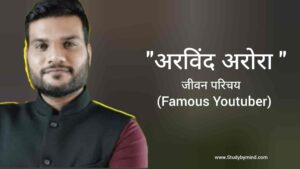Azad’s childhood/early life
The exciting life of Chandrashekhar Azad started from the age of 13. He was born on 23 July 1906 in Bhavra Tehsil Alirajpur princely state. Chandrashekhar Azad biography and his great works. His father was Sitaram ji and mother was Jagrani Devi. Azad’s parents spent most of their lives in the princely state of Alirajpur. He got Azad admitted in the primary school of Bhavra tehsil. But he was able to study in that school for a very few days, Azad’s mother Jagarani Devi was the third wife of his father Sitaram Tiwari.
चंद्रशेखर आज़ाद की बायोग्राफी हिंदी- “Click here”

Chandrashekhar Azad (Indian freedom fighter)
- Born– 23 July 1906 Badarka, Unnao Uttar Pradesh
- Died – 27 February 1931 (age 24, Allahabad)
- mother’s Name– Jagrani Devi and Father’s Name Sitaram Tiwari
- Cause of Death– Suicide by Gun
- Other names – Balraj, Azad, Panditji
- Profession – Revolutionary
Azad’s visit to Bombay
One day at the age of 13, Azad had brought mangoes from an orchard in the state in which his father was a superintendent, so because of this there was a fight between both the father and the son, Sitaram ji was very angry, his Had to say that you have brought mangoes from there without taking anyone’s permission, return them and apologize to them. Don’t come Azad ji had gone to the house of his cousin Manoharlal Tiwari in the nearby village. But there, Chandrashekhar heard about the dispute between his brother and sister-in-law, she was saying that he should leave his house in the morning, Azad had thought at the same time that he would not stay here anymore. Azad left his cousin’s house at 4 in the morning when everyone was sleeping. He walked towards the milk, if he got tired, he would take some rest and start walking again. If there was no money nearby, he would go hungry. And traveled about 40 miles within 24 hours and he reached Dohad station. After going to a compartment of the train that was standing there, the exhausted fell asleep. When I opened my eyes, I saw that there was a big railway station. He got out of the train and inquired, then he came to know that he had come to Bombay. He went towards the city, saw a hotel near the warehouse there, he started working there, the shopkeeper used to let him eat both the time and sleep outside the shop at night. After some time Azad started working with the laborers in the warehouse and started sleeping with them in his cell. He used to watch movies after saving some money. He had also bought a new kurta and a dhoti. Azad had gone to Banaras at the age of 15. After reaching Banaras, Azad started studying in a Hindi school. He also started exercising in the arena. Within a few days, his body became strong, his face became round and body became stout. And he became strong. He went to jail at the age of 15, due to the movement started by Mahatma Gandhi. Many people were going shouting slogans of Mahatma Gandhi ki Jai, Azad ji also took a bhanda in his hand, shouting slogans of Mahatma Gandhi ki Jai jumped into the movement. All were caught, produced in court and punished.
Special events in the life of Chandrashekhar Azad-
- Kakori Dacoity – Kakori Dacoity took place on 6th August 1925 in which many revolutionaries were involved. But at the time of one action, there were only three members who were fit and strong in body. They were, Bismil, Ashfaq Allah and
Azad Mr. The train robbed near Kakori had shocked the government. Because the robbers were not ordinary robbers. But he was an educated revolutionary. - Delhi Assembly Bomb Case – In March 1929, a special meeting of the party was held in Agra. In those days, two bills were introduced by the government in the assembly. One was the Industrial Disputes Act and the other was the Public Safety Act. The intention of both these laws was to suppress the spirit of freedom of the people and to suppress their discontent. Almost the whole of India was opposing these two laws. All the members in the assembly were against them except the government officers and their comrades. Azad decided to detonate a bomb in the government assembly, in which Bhagat Singh and Dutt came forward. On 8 April 1929, Bhagat Singh threw a bomb near the government officials in the government assembly and both shouted loudly “Inquilab Zindabad”, “imperialism be destroyed“, workers of the world unite“. Bhagat Singh and Dutt were caught, both were given life imprisonment.
Arrival in Kanpur
Chandrashekhar Azad had gone from Jhansi to Kanpur where he was introduced to other members of the team. Among those members were Vijay Kumar Sinha, Batukeshwar Dutt, Ajay Ghosh, Surendra Pandey, Ramdulare Trivedi, Shiv Verma, Jaidev Kapoor, Sadgurudayal Awasthi, Virbhadra Tiwari and Ganesh Shankar Vidyarthi. It was here that he also met Bhagat Singh and Sukhdev. His place of work was now this city. The backward members of Kakori were also reunited. Those teams kept on expanding the area. Not only in Kanpur, but new members were being recruited in all the big cities like Gwalior, Jhansi, Saharanpur, Dehradun, Delhi, Allahabad etc. These days the Naujawan Bharat Sabha was also gaining momentum in Lahore. In it, Bhagwati Charan Bohra, Dhanwantri, Bhagat Singh, Sukhdev, Yashpal, Durgadas Khanna, Ranveer etc. openly incited people against the British government through lectures.

Hindustan Socialist Republican Army (1925)
In the year 1925, with many efforts of Chandrashekhar and Bhagwati Charan Bohra, Bhagat Singh, Sukhdev, Dhanwantri, Yashpal (Punjab),
With the help of Shivdev Varma, Jaidev Kapoor, DV Tilag (M.P.), Kashiram (Delhi), Kundanlal (Rajasthan) etc., the organization of the party was done smoothly in almost all of North India. The credit for this was only to Chandrashekhar Azad. Till now the name of this party was Hindustan Republican Army. But times were changing and the organization too had grown far ahead of the army. In September 1925, the party meeting was held in Dohli, in this meeting the name of the organization was changed to Hindustan Socialist Republican Association and Army, and Azad was appointed Commander-in-Chief.
Mahatma Gandhi and the Revolutionary Party
Mahatma Gandhi wrote an article in his weekly paper “Young India” on the cut of the bomb. In which he had called the revolutionaries very bad and described them with names like stupid, misguided etc. Azad was deeply hurt by that article. and watched in harmony. He used to tell most of the party members that the party’s actions would complement the work of the Congress, not be against it. After all, both were fighting for independence.
Congress was born in 1885, but till 1918 the activities and work of Congress took a different form. Balgangadhar Tilak was also one of the leaders of the Congress at that time, but he used to propagate a militant policy, he had given the slogan of “Swarajya is my birthright” to the country. Mahatma Gandhi had come to know at the beginning of the Second World War that the leaders of the highest order he thought had left him, but the revolutionaries were more truthful, they supported and he used to say on a sting, That he believes in the path of violence.
Death of Azad (1931)
On February 27, 1931, the British police surrounded him in Alfred Park, and started firing on him. Azad ji also started fighting with a pistol in his single hand. Bullets were being fired on him from all sides. It was almost 17 -18 minutes. The magazine was over with Azad ji, when he saw that only one bullet was left, then according to his firm determination, that he would never fall in the hands of the police while he was alive. He left his last bullet by putting himself on his forehead. His holy and great soul left his body and got into the parts of nature. This 10 years of Azad’s life, in which he shook the roots of the British government, 10 years in which he had not lived even a day for himself and dedicated it for the country.
On August 15, 1947, 26 years after the martyrdom of the immortal revolutionary Chandrashekhar Azad, his dream of India’s independence was fulfilled, but he could not see it alive. In 1988, the Government of India issued a postage stamp in the memory of the great sacrificer Azad in his name.
Read also-
- To know more about Chandrashekhar Azad– “Click here”
- Dr. Bhimrao Ambedkar Biography– “Click here”


